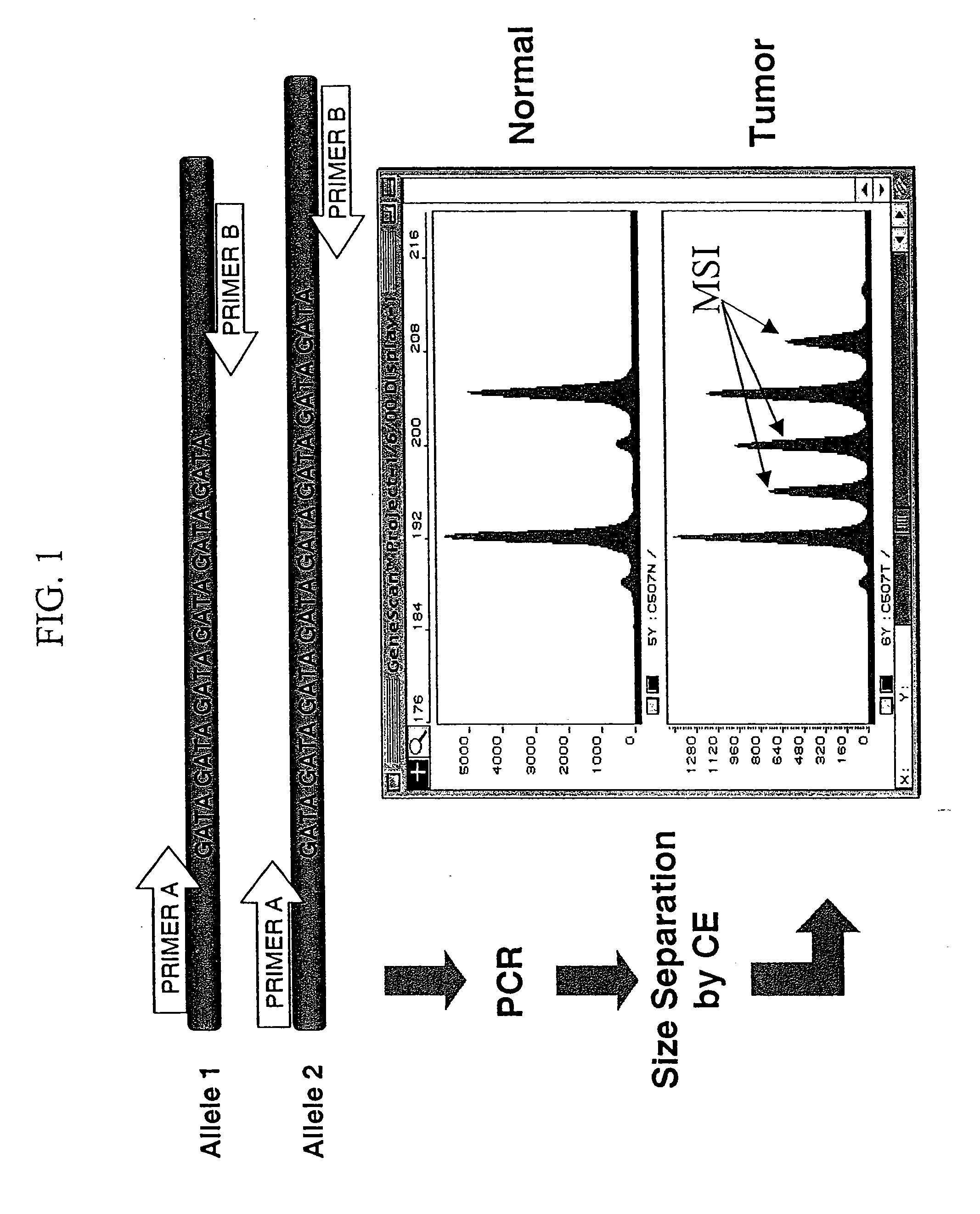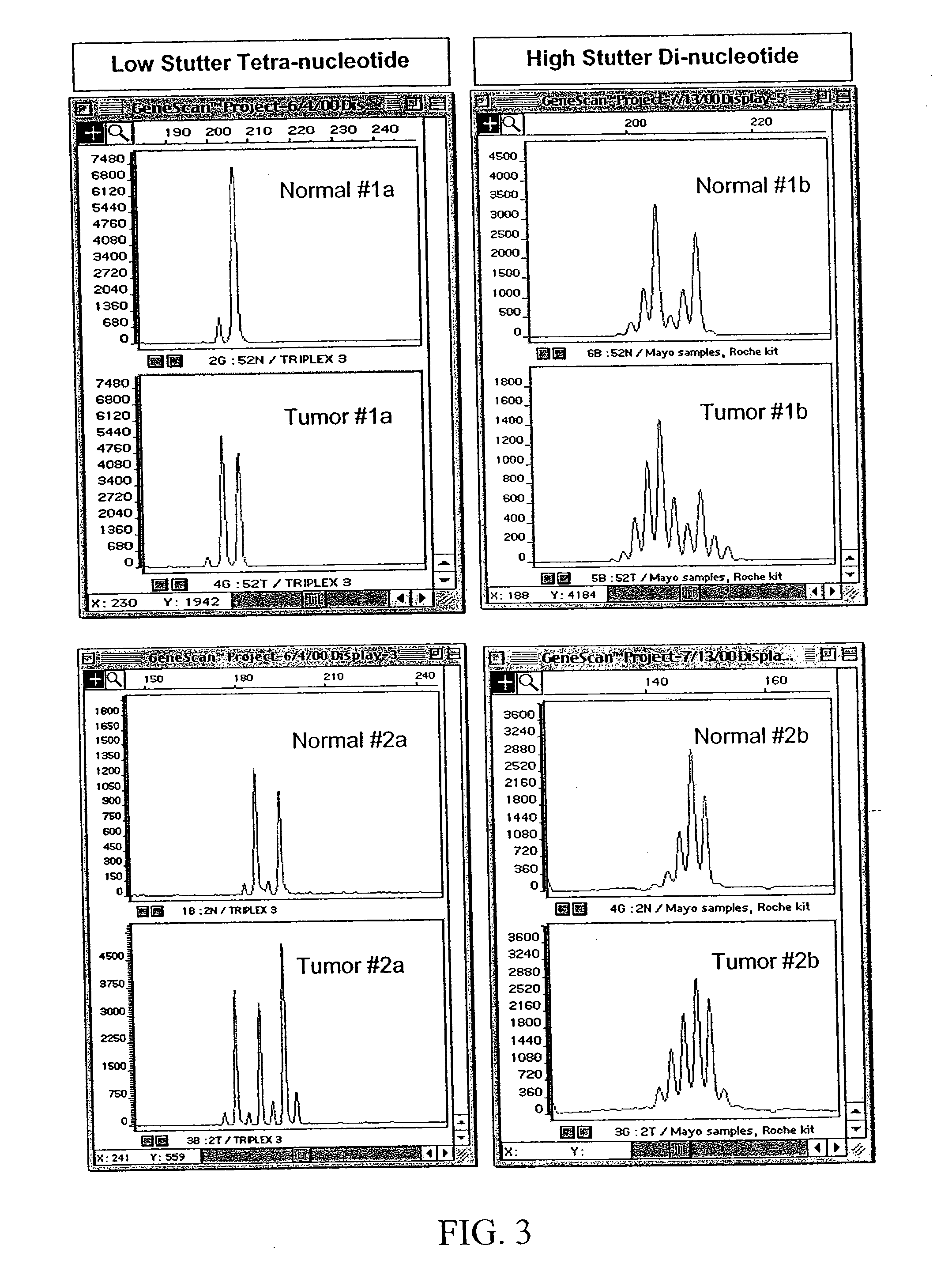Detection of microsatellite instability and its use in diagnosis of tumors
a microsatellite instability and tumor technology, applied in the field of tumor diagnosis and tumor detection, can solve the problems of high mutation rate, increased likelihood of tumor development, widespread alterations in microsatellite regions,
- Summary
- Abstract
- Description
- Claims
- Application Information
AI Technical Summary
Benefits of technology
Problems solved by technology
Method used
Image
Examples
example 1
Screening Microsatellite Markers for Frequency of MSI
[0096] In this example, microsatellite markers in DNA isolated from tumors were compared to microsatellite markers in DNA isolated from normal tissue or cells in order to detect MSI. Specifically, microsatellite loci were amplified from paired normal / tumor DNA samples and genotyped. If one or more different alleles were present in the tumor DNA sample that were not found in normal sample from the same individual, then it was scored as MSI positive. Dinucleotide, tetranucleotide and pentanucleotide repeat microsatellite markers were analyzed for frequency of alteration to determine the relative sensitivity of particular markers to MSI. Detailed information about the specific procedures used in this example are provided herein, below.
[0097] Tissues and DNA isolation. Matched normal (blood) and neoplastic tissue samples for 39 patients were obtained from the Cooperative Human Tissue Network (hereinafter, “CHTN”)(Ohio State Universi...
example 2
Identification and Characterization of Mononucleotide Repeat Loci
[0106] Due to the highly informative nature of mononucleotide repeat loci in determining MSI phenotype, we also investigated poly (A) regions of the human genome as a new source of markers for MSI assays. To accomplish this, mononucleotide repeats were identified from GenBank using BLASTN (Altschul, et al. 1990 J. Mol. Biol. 215:402-410) searches for (A)30(N)30 sequences. The (N)30 sequence was added to eliminate frequent mRNA hits and to assure that flanking sequence was available for designing primers for PCR. Next, flanking primers were designed for 33 GenBank DNA sequences using Oligo Primer Analysis Software version 6.0 (National Biosciences, Inc., Plymouth, Minn.) to amplify the region containing the poly (A) repeat. Evaluation of loci was performed using 9 MSI-H and 30 MSS colon cancer samples and corresponding normal DNA samples. Protocols for PCR, detection and analysis are described in Example 1.
[0107] Two ...
example 3
Population Studies
[0109] A population study was conducted in which 93 samples from African-American individuals were genotyped using preferred microsatellite loci selected as candidates for multiplexing in the studies illustrated in Examples 1 and 2, above. See Table 6, below, and Table 3, above, for the amplification conditions used. See Table 7, below, for a list of the loci amplified and analyzed in this study. In addition, a pooled Human Diversity DNA sample and control CEPH DNAs 1331-1 and 1331-2 (Coriell Cell Repository, Camden, N.J.) were included in the screening population. African-American samples were used because they contain the greatest genetic diversity found in all racial groups.
[0110] To facilitate screening of 96 samples with 22 different microsatellite markers, selected markers were multiplexed in small groups of three. Multiplexed primer sets were used to amplify individual sample DNAs using conditions described below.
TABLE 625 μl PCR reactionVolume PerPCR Ma...
PUM
| Property | Measurement | Unit |
|---|---|---|
| Temperature | aaaaa | aaaaa |
| volume | aaaaa | aaaaa |
| size | aaaaa | aaaaa |
Abstract
Description
Claims
Application Information
 Login to View More
Login to View More - R&D
- Intellectual Property
- Life Sciences
- Materials
- Tech Scout
- Unparalleled Data Quality
- Higher Quality Content
- 60% Fewer Hallucinations
Browse by: Latest US Patents, China's latest patents, Technical Efficacy Thesaurus, Application Domain, Technology Topic, Popular Technical Reports.
© 2025 PatSnap. All rights reserved.Legal|Privacy policy|Modern Slavery Act Transparency Statement|Sitemap|About US| Contact US: help@patsnap.com



